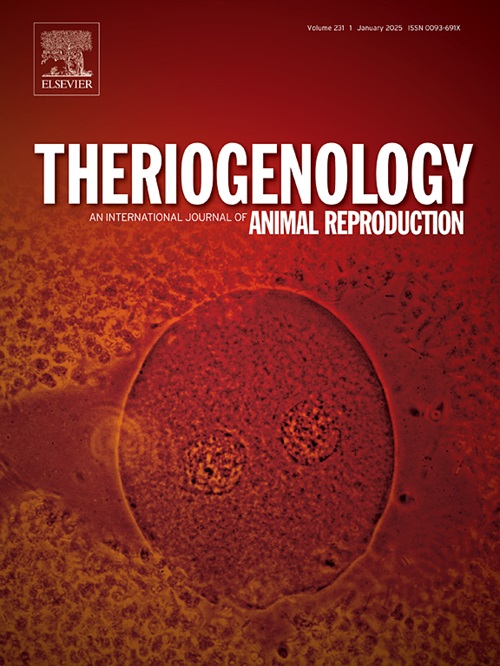Sperm collection in the domestic cat: A comparison of two techniques
IF 2.4
2区 农林科学
Q3 REPRODUCTIVE BIOLOGY
引用次数: 0
Abstract
Semen collection in cats in the clinic setting can be difficult. However, semen analysis is vital when evaluating breeding soundness of a male. Electroejaculation (EEJ) is currently the most reliable semen collection method but requires specialized equipment and training of the operator. Chemical ejaculation followed by urethral catheterization (UC) is a technique that allows semen collection without special equipment: a catheter is placed into the urethra of a sedated tom and semen is collected passively into the catheter. Earlier studies used the sedative medetomidine at high doses for this procedure. However, medetomidine has been replaced with dexmedetomidine in some countries. This study sought to compare the results of EEJ and UC for semen collection in the domestic cat using dexmedetomidine, a potent α2-adrenoceptor agonist (α2A), as a substitute for medetomidine at the equivalent dose to that used in earlier studies. Twelve domestic cats were collected thrice at weekly intervals. All cats received intramuscular ketamine (5 mg/kg) and intramuscular dexmedetomidine (30 μg/kg) for initial cleanout via EEJ, then randomly underwent either EEJ or UC one week apart. The EEJ was performed under the same anesthetic protocol as the initial cleanout. The UC was performed using intramuscular dexmedetomidine at a dose of 60 μg/kg. Success of collection, total sperm number, sperm morphology, and motility characteristics were analyzed. Sperm was collected successfully from all 12 cats via EEJ and from 11/12 via UC. There were no significant differences in the percentage of total motile, progressively motile, or morphologically normal sperm between ejaculate types when averaged across all cats or individual cats. Although UC yielded a lower volume and higher concentration ejaculate, it consistently produced a lower total sperm number than ejaculates retrieved via EEJ (17.91 x 106 total sperm for UC versus 46.51 x 106 total sperm for EEJ). These results indicated that dexmedetomidine is a very effective sedative and performed satisfactorily in both procedures at the doses used in this study. It was also safe with no adverse effects on healthy toms. EEJ remained the most reliable in terms of assessing semen quality and retrieving semen with adequate number of sperm for breeding purposes. However, UC with dexmedetomidine at this dose demonstrated a 92 % success rate, presenting itself as a remarkably consistent alternative.
家猫的精子采集:两种技术的比较。
在诊所采集猫的精液可能很困难。但是,精液分析对于评估雄猫的繁殖能力至关重要。电射精(EEJ)是目前最可靠的精液采集方法,但需要专门的设备和对操作人员的培训。化学射精后尿道导管插入法(UC)是一种无需特殊设备即可采集精液的技术:将导管插入镇静的雄性动物的尿道,精液被动地收集到导管中。早期的研究在此过程中使用了高剂量的镇静剂美托咪定。但在一些国家,美托咪定已被右美托咪定取代。本研究试图比较在家猫精液采集中使用 EEJ 和 UC 的结果,使用右美托咪定(一种强效 α2-肾上腺素受体激动剂 (α2A))替代美托咪定,其剂量与早期研究中使用的剂量相当。每周收集三次 12 只家猫。所有猫都接受了肌肉注射氯胺酮(5 毫克/千克)和肌肉注射右美托咪定(30 微克/千克),通过 EEJ 进行初步清理,然后随机接受 EEJ 或 UC,间隔一周。EEJ 在与初始清理相同的麻醉方案下进行。UC 采用肌肉注射右美托咪定,剂量为 60 μg/kg。对采集成功率、精子总数、精子形态和活力特征进行了分析。所有 12 只猫都通过 EEJ 成功采集到了精子,11/12 只猫通过 UC 成功采集到了精子。将所有猫或每只猫的精液平均计算,不同类型的精子在总活动力、渐进活动力或形态正常精子的百分比上没有明显差异。虽然 UC 的射精量较少,浓度较高,但其产生的精子总数始终低于通过 EEJ 提取的射精(UC 的精子总数为 17.91 x 106,而 EEJ 的精子总数为 46.51 x 106)。这些结果表明,右美托咪定是一种非常有效的镇静剂,在本研究使用的剂量下,它在两种手术中的表现都令人满意。此外,右美托咪定也很安全,不会对健康睾丸产生不良影响。就评估精液质量和提取精液中足够数量的精子用于繁殖目的而言,EEJ 仍然是最可靠的方法。不过,在此剂量下使用右美托咪定进行 UC 的成功率为 92%,是一种非常稳定的替代方法。
本文章由计算机程序翻译,如有差异,请以英文原文为准。
求助全文
约1分钟内获得全文
求助全文
来源期刊

Theriogenology
农林科学-生殖生物学
CiteScore
5.50
自引率
14.30%
发文量
387
审稿时长
72 days
期刊介绍:
Theriogenology provides an international forum for researchers, clinicians, and industry professionals in animal reproductive biology. This acclaimed journal publishes articles on a wide range of topics in reproductive and developmental biology, of domestic mammal, avian, and aquatic species as well as wild species which are the object of veterinary care in research or conservation programs.
 求助内容:
求助内容: 应助结果提醒方式:
应助结果提醒方式:


